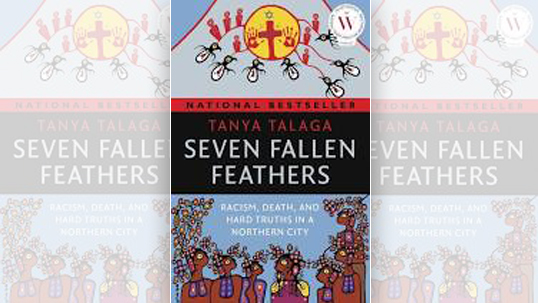Author: Tanya Talaga

Hearing a sound through reading it off a page is a particular experience. One hears the impression that the sound left on the writer, an impression so deep that it survives through ink or pixilation only to take hold in the brain of the reader and live again. For Tanya Talaga in Seven Fallen Feathers that sound reverberated through Norma Kejick’s memory and will continue as I pass it on now through Talaga’s words, but it is the source of the sound that carries the strength to create a space in all who hear it, it is “the sound of a mother losing her child” (p. 2705).
Seven Fallen Feathers is an account of the deaths of Indigenous students in the Ontario educational system from twelve-year-old Chanie Wenjack in 1966, who died running away from a residential school, to the deaths of seventeen-year-old Tammy Keeash, and fourteen-year-old Josiah Begg, whose bodies were found within two weeks of each other in the waters that surround Thunder Bay in 2017. Talaga highlights the deeply entrenched racism in governing institutions in the city by exposing the paradigm of tiered justice and education systems for Indigenous students. Talaga also includes hate crimes against Indigenous citizens like Barbara Kentner, “the Indigenous mother from Wabigoon Lake Ojibway Nation who was hit in the stomach by a trailer hitch that was thrown out of a moving car on January 29, 2017. Her sister Melissa, heard someone in the car say, “I (expletive) got one of them.”” (pg. 3652) Barbara died on July 4, 2017 from the injuries she sustained in the incident. It should be noted that in December 2020, 22-year-old Brayden Bushby was convicted of manslaughter in her death and while the crown is asking for eight to twelve years, Bushby is still awaiting his sentence.
Seven Fallen Feathers offers the details of the lives and deaths of seven Indigenous teens who died over the span of 11 years while attending high school in Thunder Bay, their names are: Jethro Anderson, Curran Strang, Paul Panacheese, Robyn Harper, Reggie Bushie, Kyle Morrisseau, and Jordan Wabasse. All of these students had to leave their families and move to a place plagued with the hatred noted above, to reside with little or no supervision, in order to gain access to education.
Talaga describes the culture of racism that led to the student’s deaths and the subsequent systemic failure to investigate that will forever withhold the truth of how they died from their families. The cornerstone of this system is the Indian Act which Talaga points out “has been described as a form of apartheid, a piece of legislation designed to control and tame the Indigenous population” (p. 701). An education true to this form of legislation will certainly result in the death of students, but as noted in the review by Jade Colbert in The Globe and Mail, “Talaga makes clear how Thunder Bay is symptomatic, not the problem itself”, Jade continues to call it “a book to be justly infuriated by”(2017). Likewise, Publishers Weekly calls the book “heartbreaking and infuriating” (2017).
According to the United Nations Declaration of the Rights of Indigenous Peoples, Talaga reminds us, Indigenous children have the right to “all levels and forms of education of the State without discrimination”(p. 2449), and swiftly thereafter offers the details of Cindy Blackstock’s human rights complaint against the Canadian government for racial discrimination against Indigenous children. Amidst the litany of reasons Talaga offers as evidence of the stark inequities in the education system is the story of Kyle Morrisseau, a 17-year-old student in Thunder Bay whose body was pulled from the McIntyre River in 2009. Kyle was the grandson of famed Indigenous Canadian artist Norval Morrisseau, son of artist Christian Morrisseau, and an artist in his own right, yet he attended a school where his “final mark for visual arts was 2 percent”(p. 3031). Clearly the school system fails to account for the fact that survival trumps learning. It is Christian Morrisseau who paints what becomes the cover of the novel, a painting called Seven Fallen Feathers because he was “tired of hearing them being called [the] “seven dead students” as if they weren't anything else in life” (p. 3573). The painting is “a Masterpiece...a requiem for his first born son” (p. 3589).
In Seven Fallen Feathers Talaga interweaves traditional Ojibway teachings of “giant Nanabijou” (p. 52) and Anishinaabe teachings of the “seven principles” (p. 34), and the prophecy of the “seven fires” (p. 218) which I will not reiterate as they are not my traditions to share but I will say that they reflect the world from which Talaga, as a truth-teller, mingles past and present so seamlessly that she breaks through the boundaries of time as we know it with her compelling look to the future through Grand Chief Alvin Fiddler of the Nishnawbe Aski Nation’s thoughts on an eighth fire, as he questions whether or not “settlers and Indigenous people [will] come together as one and move forward in harmony” (p. 3748) In writing Seven Fallen Feathers Talaga is a historiographer, a poet, a judicial reviewer, a vessel for grief, and, a restorer of honour and dignity to the Indigenous youth whose lives were meant to be bigger than the system imagined, whose lives were cut short by our collective shrug of indifference. Talaga’s words call out each and every one of us for our complacency because being infuriated alone won’t change a thing.
References
Jade Colbert. (2017, October 20). “Review: Tanya Talaga's Seven Fallen Feathers, Lydia Kwa's Oracle Bone and Guillaume Morissette's The Original Face.” Theglobeandmail.com. Retrieved February 11, 2021, from: https://www.theglobeandmail.com/arts/books-and-media/book-reviews/review-tanya-talagas-seven-fallen-feathers-lydia-kwas-oracle-bone-and-guillaume-morissettes-the-original-face/article36674971/
https://www.publishersweekly.com/978-1-4870-0226-8
The review goes here
